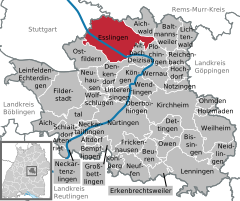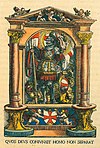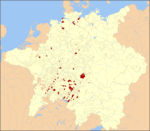Esslingen am Neckar
Esslingen am Neckar | |
|---|---|
 | |
Location of Esslingen am Neckar within Esslingen district  | |
| Country | Germany |
| State | Baden-Württemberg |
| Admin. region | Stuttgart |
| District | Esslingen |
| Government | |
| • Mayor | Jürgen Zieger (SPD) |
| Area | |
| • Total | 46.43 km2 (17.93 sq mi) |
| Elevation | 241 m (791 ft) |
| Population (2022-12-31)[1] | |
| • Total | 94,941 |
| • Density | 2,000/km2 (5,300/sq mi) |
| Time zone | UTC+01:00 (CET) |
| • Summer (DST) | UTC+02:00 (CEST) |
| Postal codes | 73701–73734 |
| Dialling codes | 0711 |
| Vehicle registration | ES |
| Website | www.esslingen.de |
Esslingen am Neckar is a city in the Stuttgart Region of Baden-Württemberg in southern Germany, capital of the District of Esslingen as well as the largest city in the district.
It is located on the Neckar River, about 14 kilometres (9 miles) southeast of Stuttgart city centre. The regions surrounding the city of Esslingen are also mostly developed.
Esslingen was a free imperial city for several centuries until it was annexed by Württemberg in 1802.
History
Prehistoric times
Through archaeological finds made in what is now the city of Esslingen there is evidence of permanent settlement since the Neolithic Stone Age. Traces of human settlement found at the site of the city church date back to around 1000 B.C.
Roman times
In the 1st century AD the Esslingen region became part of the Roman Empire. During this period a Roman warehouse was located in the area of Oberesslingen. The nearest major Roman settlements and garrisons were at Cannstatt and Köngen.
Middle Ages
Esslingen was first mentioned in 777 as Ezelinga in the last will of Abbot Fulrad from Saint-Denis (near Paris), the chaplain of Pippin and Charlemagne. He bequeathed the church sixth cell upon the river Neckar to his monastery, Saint-Denis. He also brought the bones of Saint Vitalis to Esslingen, which made it a destination for pilgrims and led to its growth.

Around 800 Esslingen became a market town, its market rights being certified in 866. In 949–953 it was a possession of Liudolf, Duke of Swabia. Esslingen received city rights in 1229 under Emperor Frederick II. During the same period the still extant Neckar bridge was built, making Esslingen a major centre for trade on the route between Italy, Switzerland, and northern Germany. Taxes provided by the bridge and market led to further growth of the town, as did the export of the highly regarded wines from the region.
The period between the 13th century and 16th century saw many conflicts between the Free Imperial City and the Counts of Württemberg (later Duchy of Württemberg). About half the population lost their lives in the Thirty Years War between 1618 and 1648 through famine or epidemics. Esslingen lost its independence as an Imperial city in 1802-1803, becoming part of the Duchy of Württemberg.
19th century to date
The beginning of 19th century was characterised by industrialisation. Glove manufacturing, food processing, textiles, and metal working were early industries in Esslingen. On 20 November 1845 the first train ran from Cannstatt to Esslingen station.
Esslingen was occupied by U.S. soldiers in April 1945, towards the end of World War II. During the war the city suffered very little damage, thus most of the medieval appearance of its city centre has been preserved.
After the Second World War about 47,000 people moved to Esslingen, mostly refugees and displaced persons from East Germany. Housing developments in Oberesslingen and Zollberg were created to overcome the shortage of housing.
In 1973 Nürtingen district was merged with Esslingen am Neckar, making Esslingen the seat of a much enlarged district.
Transport
Air transport
Stuttgart Airport, the largest airport in Baden-Württemberg, is roughly ten kilometres south of the town, on the border with the town of Leinfelden-Echterdingen. A plane owned by Lufthansa has been named after the town.
The junction on the A8 Karlsruhe-Munich Autobahn which serves Esslingen is just after the airport when travelling towards Munich.
Road Transport
Esslingen is directly on the B10 State Highway which runs as a dual carriageway from Stuttgart to Süßen, and continues onward to Ulm. The exit for Esslingen, just after the B10 passes under the ancient Pliensau Bridge, is particularly unusual, because in the direction of Ulm there are two entry and exit points to the dual carriageway. This makes it is possible to reach the centre of Esslingen directly from Stuttgart, and to drive from central Esslingen directly onto the Dual Carriageway in the direction of Ulm without having to pass traffic lights.
Despite the six to eight lanes on the new Piensau Bridge and the surrounding roads, the infrastructure around Pliensauvorstadt and the route to Zollberg still suffers from frequent congestion.
Esslingen is also on the German Timber-Frame Road.
Long Distance Rail Transport.
Esslingen (Neckar) station is on the Fils Valley Railway and is served by line S 1 of the Stuttgart S-Bahn and regional services. The town is on the main rail line between Stuttgart and Ulm, operated by Deutsche Bahn, the main German rail operator. In 2009, the company named a high speed 'Intercity-Express' train “Esslingan-am-Neckar”
S-Bahn
The Stuttgart S-Bahn line S1 which operates between Kirchheim-unter-Teck and Herrenberg via Stuttgart centre, serves the stations of Mettingen, Esslingen (Neckar), Oberesslingen and Esslingen (Zell). Under the planned rebuilding of the railways in central Stuttgart under the Stuttgart 21 scheme, the S1 will be shortened to operate from Kirchheim unter Teck as far as Stuttgart Schwabstrasse station.
Direct bus connection to Stuttgart Airport.
To avoid the long S-Bahn route to the airport via Stuttgart, the Bus 122, Operated by the END Company, now runs directly from the cantral bus and rail interchange to the airport via Ostfildern Scharnhausen.
Urban Tramway
The Esslingen Urban Tram system was opened in May 1912 and closed on the 7th of July 1944 after 32 years of operation. It was replaced by trolley buses. The operating company, the Esslinger Städtische Straßenbahn (ESS, translated Esslingen Town Tramway) changed its name in 1944 to the Städtischer Verkehrsbetrieb Esslingen (SVE, or “Esslingen Transport Company”).
Former Interurban Tram
On the 18th of December 1926 The Esslingen-Nellingen-Denkendorf (END) interurban tram began operating. This was the last tram system to be built in Germany before the wave of closures later in the century: after this date permission from the authorities was only given for extensions to existing systems. The tram had to negotiate a five kilometre gradient out of the Neckar Valley to reach the towns and villages of the Eastern Filder region. In total, the system transported 153 million passengers from Denkendorf and latterly from Neuhausen to Esslingen, and took delivery of two new open trams in 1958. The line was closed in February 1978.
Trolley bus and diesel bus
Esslingen, along with Solingen and Eberswalde, is one of the last three German towns which still use trolleybuses. The SVE currently operates two lines using electric power:
101: Oberesslingen Lerchenacker Endstation – Esslingen railway station- - Stuttgart Obertürkheim railway station.
118: Esslingen Railway Station – Zollberg.
Apart from this around 50 Taxis operate in the town.
Car-Sharing
In 1994 A car-sharing company opened a station in Esslingen.
Rebuilding of bus/rail interchange.
An ambitious redevlopment project has been progressing since 2004 in the area near the railway station. The current phase of this project is a large redevelopment of the station forecourt costing about 7.4 million Euros. The Baden-Württemberg State Environment and Transport ministry helped fund this with a grant of 4.9 million Euros. During 2009 the Neckarstrasse was diverted along unused land on the railway station and lengthened to the west of the site. The next phase, completed in November 2014, was a large scale redevelopment of the station forecourt to create a bus and rail interchange.
Hochschule Esslingen
The city is home to the Esslingen University of Applied Sciences (German: Hochschule Esslingen). It is known for its mechanical engineering and automotive engineering courses, and also for its three international master's programs (MBA in International Industrial Management,[3] MEng in Automotive Systems,[4] MEng in Design and Development in Automotive and Mechanical Engineering),[5] which are organised by the Esslingen Graduate School[6] and taught completely in English.
International relations
Twin towns – sister cities
Esslingen am Neckar is twinned with:[7]
Notable people
- Johann Ludwig Andreae (1667–1725), German Protestant parson, cartographer, globe builder and author
- Eberhard Bauer (1914–1984), entrepreneur
- Karoline Breitinger (1851–1932), first female doctor in Württemberg
- Otto Borst (1924–2001), historican
- Carl Deffner (1789–1846), entrepreneur, member of Landtag
- Dionysius Dreytwein (1498–1576), furrier and chronicler
- Albert Dulk (1819–1884), free thinker
- Konrad Feyner, 15. century, first book printer in Esslingen
- Cristian Fiél (* 1980), Spanish-German football player
- Georg Geist (1895–1974), 1946 till 1966 Landrat of district Esslingen
- Daniel Hauff (1629–1665), Esslinger advocate in the time of Esslinger witch processes
- Volker Hauff (* 9. August 1940), politician, former member of Bundestag, former Lord Mayor of Frankfurt am Main (SPD)
- Frigga Haug (* 28. November 1937), sociologist and feminist
- Wolfgang Fritz Haug (* 23. März 1936), philosopher
- Otto Hauser (* 1952), Politiker (CDU), former member of Bundestagegierungssprecher und Parlamentarischer *Staatssekretär a. D.
- Walter Hirrlinger (* 1926), Politiker (SPD), Landtagsabgeordneter, Wirtschaftsminister, 1990–*2008 Präsident des Sozialverbands VdK Deutschland, 1953 bis 1968 Gemeinderat in Esslingen
- Emil von Kessler (1813–1867), founder of Maschinenfabrik Esslingen
- Friedrich Ludwig von Geß (1828–1905), jurist and politician, member of Reichstag and Landtag
- Emil von Keßler jun. (1841–1895), director of machine factory Esslingen about 1885, son of Emil *von Keßler
- Georg Christian von Kessler (1787–1842), founder of sparkling wine cellar
- Philipp Knipschild (auch Knipschildt; 1595–1657), jurist und Rechtshistoriker
- Cosmann Friedrich Köstlin (1711–1790), „Senior Ministerii“ (Oberpfarrer) der Reichsstadt *Esslingen, Scholarcha („Schuldezernent“) und Eherichter
- Nikolai von Koslowski (* 1958), Hörfunkregisseur
- Hermann Kurz (1813–1873), poet, author and translator
- Alfred Leikam (1915–1992), Notar, politician, Righteous among the Nations
- Reinhart Lempp (1923–2012), Kinder- und Jugendpsychiater, emeritierter Professor der Universität Tübingen
- Andreas Lonardoni (* 1956), composer, musician
- Heinz Maier-Leibnitz (1911–2000), physicist
- Tobias Mayer (1723–1762), Kartograf, Mathematiker und Astronom
- Johannes Merkel (1798–1879), founder of factory Firma Merkel & Wolf, later Merkel & Kienlin (Wollene *Strickgarne, Kammgarnspinnerei)
- Hans Meyer (1867–1949), Architect of Merkel swimming pool
- Wilhelm Murr (1888–1945), politician (NSDAP)
- Karl Oppel (1816–1903), author, besuchte von 1833 bis 1835 das Lehrerseminar in *Esslingen am Neckar
- Paula Rueß (1902–1980), resistance fighter and Frauenrechtlerin
- Thomas Ruf (1911–1996), politician, Member of Bundestag district Esslingen
- Giovanni Salucci (1769–1845), Italian architect, entwarf den Pavillon in Weil
- Valentin Salzmann (1821–1890), founder und first chairman of Schwäbischen Albvereins, *Gründer des Esslinger Verschönerungsvereins
- Agnes Sapper (1852–1929), author
- Eugenie von Soden (1858–1930), editor dreibändigen Frauenhandbuches, author
- Heinrich Schickhardt (1558–1635), builder of duchy Württemberg
- Louis Schlegel (1858–1929), politician, member of Reichstag and Landtag
- Ronja Schmitt (* 1989), politician, member of Bundestag
- Jakob Ferdinand Schreiber (1809–1868), founder of J.-F.-Schreiber-publisher, known for children books
- Hans Erich Slany (1926–2013), designer and professor
- Michael Stifel (* um 1487–1567) theologian, mathematician
- Pantlion Sydler (* um 1460–1521) belleter and Waffenhersteller
- Serdar Tasci (* 1987) German footballer of Turkish descent
- Claudio Urru (* 1971), cook
- Alexander Christian Friedrich von Württemberg (1801–1844), poet and colonel lieutenat of in Esslingen stationed 3. Württembergischen Reiterregiment
|
|
References
- ^ "Bevölkerung nach Nationalität und Geschlecht am 31. Dezember 2022" [Population by nationality and sex as of December 31, 2022] (CSV) (in German). Statistisches Landesamt Baden-Württemberg. June 2023.
- ^ Translated from Wikipedia Germany
- ^ "MBA in International Industrial Management". Graduate-school.de. Retrieved 16 April 2013.
- ^ "MEng in Automotive Systems". Graduate-school.de. Retrieved 16 April 2013.
- ^ "MEng in Design and Development for Mechanical and Automotive Engineering". Graduate-school.de. 8 April 2013. Retrieved 16 April 2013.
- ^ "graduate-school.de". graduate-school.de. 8 April 2013. Retrieved 16 April 2013.
- ^ "Esslingen und seine Partnerstädte". Esslingen.de (official website) (in German). Städtepartnerschaften, Stadt Esslingen am Neckar. Retrieved 17 November 2014.
- ^ "Neath Port Talbot Twin Towns". Neath Port Talbot County Borough Council. Retrieved 22 August 2013.




